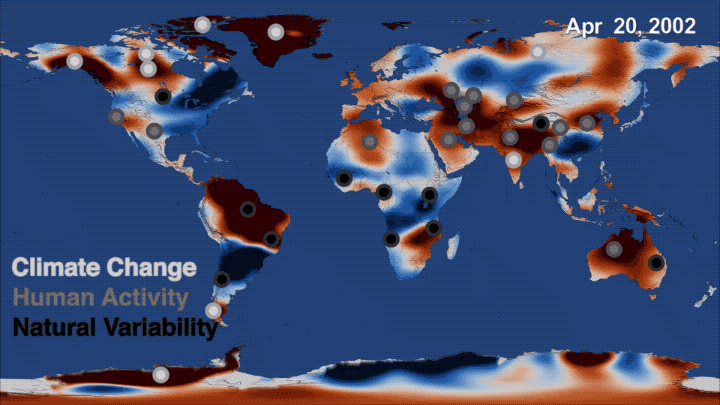NASA Satellites Track Unusual Changes in Earth's Water Supplies

Fresh water is changing around the world, and a new set of NASA satellite observations is helping scientists better understand why. A new study suggests that the changes stem from human activities as well as natural variations in the climate.
The data comes from 14 years of observations from the U.S./German Gravity Recovery and Climate Experiment (GRACE) spacecraft mission. A successor mission called GRACE Follow-On is expected to launch from Vandenberg Air Force Base in California on SpaceX's Falcon 9 rocket no earlier than today (May 22) at 3:47 p.m. EDT (12:47 p.m. PDT, 1947 GMT). You can watch it live here on Space.com, courtesy of NASA TV.
The study, published May 16 in the journal Nature, shows that wet zones on Earth are getting even wetter, while dry zones are drying up, according to a statement from NASA. This is due to many factors, including climate change, how humans use water and natural environmental cycles.
Besides the GRACE data, researchers incorporated precipitation data from satellites under the Global Precipitation Climatology Project, imagery from the NASA/U.S. Geological Survey Landsat set of satellites, maps of irrigation, and reports of human activities in mining, agriculture and reservoir operations.
"This is the first time that we've used observations from multiple satellites in a thorough assessment of how freshwater availability is changing, everywhere on Earth," Matt Rodell, the team lead and chief of hydrological sciences at NASA's Goddard Space Flight Center in Maryland, said in the statement.
"A key goal was to distinguish shifts in terrestrial water storage caused by natural variability — wet periods and dry periods associated with El Niño and La Niña, for example — from trends related to climate change or human impacts, like pumping groundwater out of an aquifer faster than it is replenished."
Changes in fresh water, particularly from ice near the poles (such as ice melting due to increasing temperatures), could affect how quickly sea levels rise, NASA officials said. Understanding those changes is also important for predicting the supplies of drinking water and land that is suitable for agriculture.
Get the Space.com Newsletter
Breaking space news, the latest updates on rocket launches, skywatching events and more!
Fresh water on Earth is located in soil, rivers, lakes, groundwater and ice, and changes in its quantities were already predicted by Intergovernmental Panel on Climate Change models. However, scientists said they would need a longer data set than that of GRACE (which operated from 2002-2007) to see if climate change is responsible for the freshwater changes the twin satellites observed.
GRACE calculated the distance between the two spacecraft as they orbited Earth to detect changes in Earth's gravity field below, caused by changes in the distribution of mass across the globe. The satellites also looked at changes in terrestrial water storage.
"We examined information on precipitation, agriculture and groundwater pumping to find a possible explanation for the trends estimated from GRACE," study co-author Hiroko Beaudoing, a computer scientist at Goddard and the University of Maryland in College Park, said in the statement.
The GRACE data not only shows the effects of climate change, such as on melting ice, but also shows how groundwater levels are sensitive to areas experiencing drought or high rain conditions due to natural cycles in the climate.
In southwestern California, for example, groundwater was lost between 2007 and 2015 due to natural water cycles, according to the statement. Less precipitation fell, leading to less snow and surface water, so residents had to use more groundwater to meet their needs.
Some zones did not appear to be affected by human activities, such as Africa's western Zambezi basin and Okavango Delta that nourishes wildlife in northern Botswana. Water storage increased every year, on average, by 29 gigatons between 2002 and 2016. But before GRACE's observations, the same region underwent at least 20 years of dry conditions that are attributed to natural environmental cycles.
Follow us @Spacedotcom, Facebook and Google+. Original article on Space.com.
Join our Space Forums to keep talking space on the latest missions, night sky and more! And if you have a news tip, correction or comment, let us know at: community@space.com.

Elizabeth Howell (she/her), Ph.D., was a staff writer in the spaceflight channel between 2022 and 2024 specializing in Canadian space news. She was contributing writer for Space.com for 10 years from 2012 to 2024. Elizabeth's reporting includes multiple exclusives with the White House, leading world coverage about a lost-and-found space tomato on the International Space Station, witnessing five human spaceflight launches on two continents, flying parabolic, working inside a spacesuit, and participating in a simulated Mars mission. Her latest book, "Why Am I Taller?" (ECW Press, 2022) is co-written with astronaut Dave Williams.
